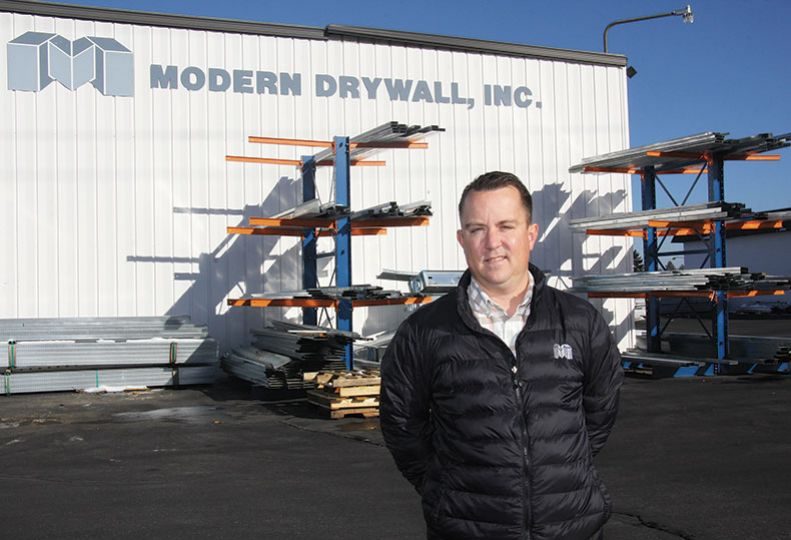
Home » Central Washington pay rates rile Spokane-area contractors
Central Washington pay rates rile Spokane-area contractors
State Supreme Court upholds 2018 changes for setting prevailing wage

November 17, 2022
Prevailing wages in some central Washington counties have increased 40% from a year ago for carpenters, and some construction industry professionals here say they’re concerned about the impact of the wage hike on Eastern Washington contracting companies.
Brad DePew, Spokane general manager at Lenexa, Kansas-based Performance Contracting Inc., says that historically, wages in the central Washington counties of Okanogan, Kittitas, Chelan, Douglas, and Yakima mirrored Eastern Washington’s wage rate. Prevailing wage rates, which are those the state requires on public projects, are updated twice yearly, in February and in August.
However, on Sept. 1, the prevailing wage rate for carpenters in those central Washington counties jumped dramatically to $71.53 per hour, from $51.25, due to change in state law involving collective bargaining agreements and how they are applied in different parts of the state.
DePew says, “My biggest concern is that these five counties, which are probably some of the poorest in the state of Washington, have budgets for schools, hospitals, jails, and community centers, and their budgets for a trade like carpentry that does everything from the framing to the roofing, have gone up $20 an hour (per carpenter). It’s a pretty hefty poke overnight.”
Brad Mickelson, president of Modern Dry Wall Inc., says central Washington’s prevailing wage has been the same as Eastern Washington’s “without exception for decades. What is currently posted as prevailed carpenter wages in central Washington is without precedent.”
Prevailing wages are required for construction projects using public funds for public works projects.
Washington state’s Prevailing Wages on Public Works Act was enacted in 1945, and the law is designed to ensure workers are paid fairly, according to the state’s Department of Labor & Industries. Prevailing wages are the hourly wages, usual benefits, and overtime paid in the largest city in each county, to the majority of laborers, performing the same work, according to the L&I website. A separate rate is calculated for each county.
Usual benefits include medical insurance paid through an employer, pensions, apprenticeship programs, and vacation and holiday pay. Benefits that are required by law aren’t considered usual benefits.
Mickelson says Western Washington’s prevailing wage rates are higher than in Eastern Washington largely because of the higher cost of living on the West Side.
L&I sets the wage through industrial statisticians, and the agency also enforces the wage requirements.
Cheryl Stewart, executive director of the Associated General Contractors of America Inland Northwest chapter, says the prevailing wage statute was challenged by the association when amendments were introduced in 2018 that changed how the rate is set.
Stewart says, “A couple years ago, the Legislature passed a rule that said, if there was a collective bargaining agreement in a county for a specific trade, that would become the prevailing wage.”
Instead of allowing L&I statisticians surveying contractors to set the rate, as occurred previously, a recent ruling from the Washington state Supreme Court upheld the statute tying the prevailing wage to the highest collective bargaining agreement in each county.
Under the rule, contractors will submit their collective bargaining agreements to the state, L&I will review each agreement, and the agreement that has the highest wage for that county will set the prevailing wage.
“We helped negotiate this law, and we were okay with it,” Stewart says. Although, she adds that one piece of the rule states that if there are two collective bargaining agreements in the county, then the higher of the two would be the prevailing wage, prompting the association to file a legal challenge.
The association’s lawsuit was brought about when a group of workers went on strike and two contracting companies that wanted to get back to work signed an additional collective bargaining agreement with the union at a higher rate than the areawide collective bargaining agreement at the time.
“Because it was a higher wage, it prevailed. Even though it only represented two companies,” Stewart says. “We ended up suing on the premise that the state can’t delegate it’s authority to set the prevailing wage to an outside party, which is what it’s doing.”
She explains that, by having the collective bargaining agreement set the rate, it gives power to the bargaining agent to set the wage.
“We just felt it should be the agreement that represents the most people to set the wage,” she says.
Stewart says Washington state is split at the 120th meridian for the collective bargaining agreements for five major trades, which include carpenters, operators, masons, laborers, and teamsters. AGC serves as the collective bargaining agent for contractors to bargain with unions to set the areawide collective bargaining standards.
Most companies sign the areawide agreement, although some negotiate on their own, she says. “But our contracts represent the biggest number of people in those groups. Anyone on the East Side falls under our rate.”
Under the rule, however, because the 120th meridian doesn’t follow county boundaries, the bisected counties will have the prevailing wage defaulted to the rate set for Western Washington, because it’s a higher rate.
Stewart says, “One company on the West Side, Skanska, bargained separately with the carpenters’ union that included those five counties at a significantly higher rate than what was currently prevailed and what the AGC of Washington negotiated,” Stewart says. “So those rates in those five counties jumped $20 an hour for carpenters in September.”
Because of the new law, a contract negotiated by one company prevailed, she adds.
Contractors are expressing concern regarding the new wage rates, and Mickelson and other industry leaders say that the ramifications will impact both contractors and workers in Eastern Washington.
Stewart says private projects won’t be impacted by prevailing wage rules, so workers likely will gravitate toward those companies who must pay a higher prevailing wage. While the construction industry faces continued labor shortages, the draw toward higher wages could amplify labor gaps for those other construction developments.
From a contractor’s point of view, Mickelson says, “This is going to make it impossible for union contractors, such as myself … to compete against non-union shops. We’re already at a significant disadvantage with the package that we’ve got, but now that you bump an additional ($20) an hour, bidding on projects in central Washington will be a waste of my time.”
DePew says, “One contractor can mess it up for the remainder of the contractors which is why typically the union scale prevails, because it’s a group or collective amount for the majority. That’s the whole idea behind prevailing.”
DePew says the wage rate makes it difficult for many Eastern Washington general contractors that work on central Washington public works developments to remain competitive.
“It just doesn’t seem right that the same wage would be paid in Yakima or Omak as it would be in downtown Seattle,” he says.
Mickelson adds, “It’s going to invite West Side carpenters to work in central Washington at the expense of local workers.”
He contends that, if work slows in Seattle, workers from there will be close enough to work in central Washington without taking a pay cut and likely will take jobs from local carpenters.
Modern Drywall is headquartered in Spokane Valley and works on developments throughout Eastern and central Washington. Recent projects in central Washington include Rocky Reach Dam, a new service center for Chelan County Public Utility District, and Central Washington University’s Health Education center, in Kittitas County.
Stewart says the Supreme Court only ruled on the constitutionality of the amendment, and there might be an option to appeal on other grounds, but she’s unsure what the association’s next step will be.
“We’re not opposed to the whole rule,” she says, “just that one little piece that says the highest collective bargaining agreement prevails.”
Latest News Special Report Real Estate & Construction Government
Related Articles
Related Products




![Brad head shot[1] web](https://www.spokanejournal.com/ext/resources/2025/03/10/thumb/Brad-Head-Shot[1]_web.jpg?1741642753)
